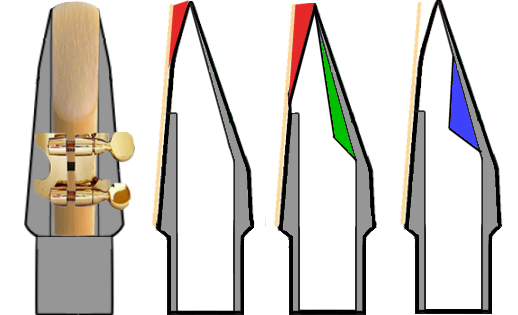
The Mouthpiece
The RED areas are to do with the "lay" of the mouthpiece - how much space the reed has to vibrate in, plus how wide those vibrations can be. The more space, the fuller the sound. The trade-off is reed-strength. With a smaller "lay" a soft reed - which will vibrate widely, and very easily - can actually touch the facing edges of the mouthpiece, which will choke off the note instantly. So a small lay might require a harder reed, simply because a harder reed vibrates less for a similar result. The problem is that you will need to blow harder, which in turn means a stronger embouchure. And a stronger embouchure needs to be developed. Worked on.
Without the reed and its ability to vibrate there is no saxophone. So the reed/mouthpiece combination is everything. Well, almost everything.
EVEN SHORTER ANSWER? Go to a music shop and ask to try a fistfull of mouthpieces. They should allow you to do just that. However, living out in the sticks, as I do, I realise that there is not a music shop on every corner. So, since you are on the net anyway, search for the nearest to you and ask if they will send you some to try. It is not an uncommon request.
The BLUE area determines the amount of "bite" in your tone. Sharpness...brightness. Back in my formative years we adjusted this facet by sticking wads of plasticine in there. Or even chewing gum! (Yes, we were an unseemly lot!) These days that element is built-in (If you want it to be). See the GREEN area.
Metal mouthpieces are perceived to produce a more modern tone. And they look really swish!